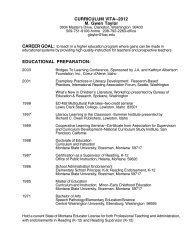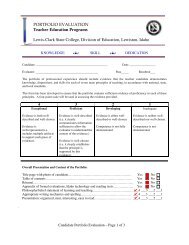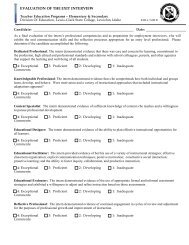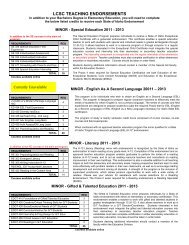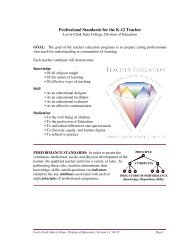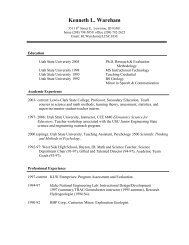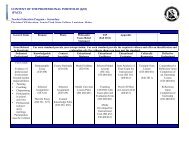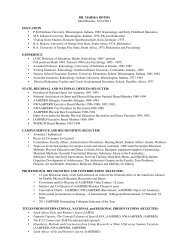PACE - LCSC Education Division - Lewis-Clark State College
PACE - LCSC Education Division - Lewis-Clark State College
PACE - LCSC Education Division - Lewis-Clark State College
Create successful ePaper yourself
Turn your PDF publications into a flip-book with our unique Google optimized e-Paper software.
• The teacher understands learning theory, subject matter, curriculum development, and studentdevelopment and knows how to use this knowledge in planning instruction to meet curriculumgoals and the continuous development of individual students’ abilities. (K, D)• The teacher can use knowledge about human motivation and behavior drawn from thefoundational sciences of psychology, anthropology, and sociology to develop strategies fororganizing and supporting individual and group work. (K, S)• The teacher knows how to take contextual considerations (instructional materials, individualstudent interests, needs, and aptitudes, and community resources) into account in both long termand short term planning instruction that creates an effective bridge between curriculum goals andstudents' experiences. (K, S, D)• The teacher knows how to plan and design effective learning environments and experiencessupported by technology. (K, S)• The teacher understands how curriculum alignment across grade levels and disciplines maximizeslearning. (K, S, D)• The teacher values planning as a collegial activity. (D)• The teacher recognizes the importance of the development of students’ critical and creativethinking, problem solving, and performance capabilities. (D, K)• The teacher implements flexibility and reciprocity in the teaching process as necessary foradapting and modifying instruction to student responses, ideas, and needs. (K, S, D)• The teacher identifies and designs instruction appropriate to students' stages of development,learning styles, strengths, needs and background. (K, S)• The teacher seeks to understand students' families, cultures, and communities, and uses thisinformation as a basis for connecting instruction to students' experiences (e.g. drawing explicitconnections between subject matter and community matters, making assignments that can berelated to students' experiences and cultures). (K, S, D)• The teacher develops and uses curricula that encourage students to recognize, question, andinterpret ideas from diverse perspectives. (K, S)• The teacher identifies levels of readiness in learning and designs lessons that are developmentallyappropriate, choosing teaching strategies, materials, and technologies to meet instructionalpurposes and student needs. (K, S)• The teacher designs activities that promote a positive classroom climate of openness, mutualrespect, support, and inquiry. (K, S)• The teacher uses information from students, parents, colleagues, and school records to assist inplanning instruction to meet individual student needs. (K, S)2. The teacher designs and develops learning opportunities, which utilize well-selected instructional strategiesand learning resources.• The teacher knows how to enhance learning through the use of a wide variety of materials as wellas human and technological resources (e.g. computers, audio-visual technologies, videotapes anddiscs, local experts, primary documents and artifacts, texts, reference books, literature, and otherprint resources). (K, S)• The teacher understands and knows how to identify differences in approaches to learning andperformance (e.g., learning styles, multiple intelligences, and performance modes) and designsinstruction that helps use students’ strengths as a basis for growth. (K, S)• The teacher knows how to take into account such elements as instructional materials; individualstudent interests, needs, and aptitudes; and community resources in planning instruction thatcreates an effective bridge between curriculum goals and student learning. (K, S)• The teacher knows how to plan for the effective use of professionals, paraprofessionals,volunteers, and peer tutors. (K, S)65



